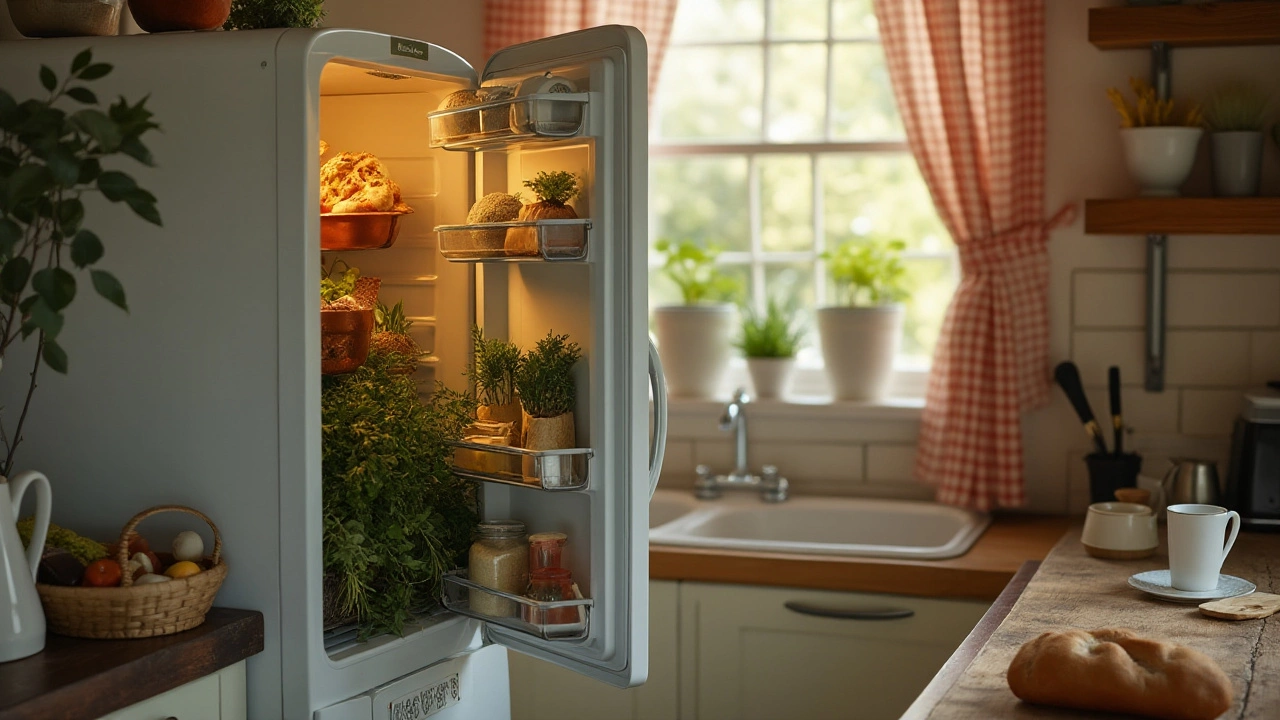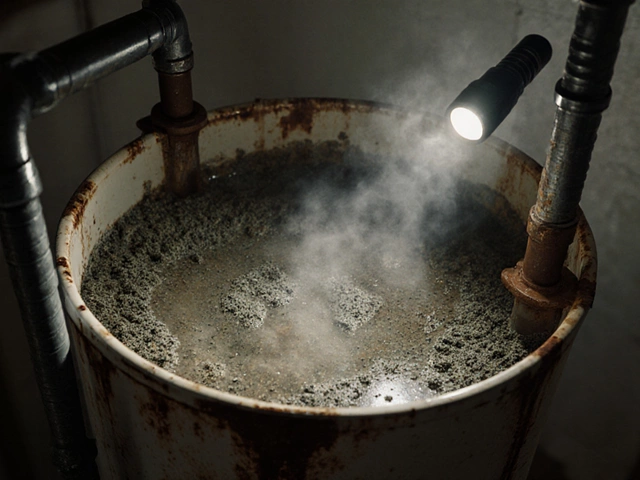Ah, the modern kitchen marvel—the refrigerator. It's there, humming quietly in the corner, doing its unassuming duty of keeping our food fresh, until one day, it doesn’t. A fridge that suddenly stops working can cause quite the panic, especially right before a holiday feast or after a long grocery run. But before you reach for the phone to call in the cavalry, there might be a simple solution waiting in the wings.
Understanding the common reasons behind a fridge's failure can not only save you time and money, but also let you tackle some of these issues yourself. From something as simple as a power outlet problem to a more intricate issue like a faulty thermostat, let's dive into why your fridge might have decided to take a day off and how you can coax it back to life.
- Power and Outlet Issues
- Thermostat and Temperature Control
- Blocked Vents and Circulation Problems
- Faulty Compressor
- Signs You Need Professional Help
Power and Outlet Issues
When you're faced with a fridge not working, starting with the power supply is a smart move. Sometimes, the simplest solution is indeed the right one. A fridge can be rendered useless if it isn't receiving electricity, and an unexpected loss of power might just be the culprit behind its sudden inertia. Start by checking if the fridge's plug is securely fit into the outlet. It's surprisingly common for plugs to become dislodged, especially if they're in an area prone to foot traffic or if the fridge has been recently moved.
Check the Outlet
Once you've ensured that the plug is firmly connected, it's time to test the outlet itself. Plug another appliance, like a lamp, into the same outlet. If the lamp doesn't light up, then it's very likely there's something wrong with the outlet. A tripped circuit breaker can cause outlets to stop working, so take a trip to your home's circuit box to see if any breakers need resetting. If you're unsure, a handy friend or neighbor can often help you distinguish a tripped switch.
"It's amazing how many fridge issues boil down to something as simple as a tripped breaker," notes Mike Stephens, a seasoned appliance repair technician. "Always start with the basics before assuming the worst."
Inspect the Power Cord
If the outlet is functioning fine, the problem might lie in the fridge's power cord. Over time, cords can become frayed or damaged due to wear and tear, particularly if they're positioned where they're frequently bent or pinched. Inspect the entire length of the cord for any visible damage. If you spot any exposed wires or signs of wear, this might be your issue. Replacing a damaged power cord can often bring your refrigerator back to life.
Use of Surge Protectors
Regular fridge users often overlook the importance of surge protectors. Power surges can easily damage the electrical components of your fridge, leading to unexpected shut-offs. If you suspect a power surge, or if it's common in your area, consider using a surge protector or a dedicated refrigerator circuit to shield against electrical spikes. Protecting these vital appliances can prevent more extensive problems in the long run.
Final Thoughts on Electrical Checks
Addressing power and outlet issues is crucial and often the easiest step in troubleshooting a fridge that won’t work, yet it's frequently overlooked in panic. These checks can save you time and a potentially unnecessary service call. By ensuring the power source is stable and reliable, you can eliminate the most obvious potential causes of a fridge's malfunction from your list. So, next time your trusty cooling companion gives you trouble, remember: start with the basics, and you might just find a simple solution hidden in plain sight.
Thermostat and Temperature Control
The thermostat, much like your fridge's brain, plays a crucial role in managing the internal climate. It's responsible for directing the compressor when to pump refrigerant and when to give it a rest. So, when your refrigerator starts acting up, the thermostat and temperature control are top suspects in this whodunit mystery. An improper setting could mean your fridge is a giant lukewarm storage container instead of the cool sanctuary it’s supposed to be. Start by checking if someone—maybe a curious toddler or a distracted adult—turned the dial by accident. Surprisingly often, the simplest answer is the right one.
If your fridge is still not humming along nicely, you'll want to test the thermostat. You can dial it up to a colder setting and listen for a click indicating it's telling the compressor to kick into gear. No click? Your thermostat might be on strike. Replacing a faulty thermostat isn’t as complicated as it sounds. Most fridges have accessible thermostats, often located inside the fridge compartment. Unplug the fridge, remove the thermostat cover, and you can replace it with a new one in a few easy steps. Here, the motto is 'safety first'—always cut the power before poking around inside.
Before you consider replacing parts, understanding how the thermostat functions can be eye-opening. This component usually consists of a bimetallic strip that expands and contracts with the fluctuating temperatures, closing or opening circuits as needed. Such intricacies remind us that a fridge, though simple in appearance, is a dance of engineering. And, as the adage goes, 'The devil is in the details.' This is no truer than when gauging fridge performance; a slight misalignment in calibration can lead to unwanted warm-ups or overcooling.
As mentioned in a consumer report by Choice magazine, "Regular thermostat checks can prevent most refrigerator malfunctions in homes."
For fridges with digital temperature controls, a reset might be in order. Screens can glitch, and commands may get stuck 'on hold.' Disconnecting the fridge for a few minutes can sometimes resolve these hiccups. When plugging it back in, give the system a moment to recalibrate and set the desired temperature anew. Sometimes a mere digital reboot is the modern magic needed.
To keep your kitchen companion running at peak performance, it’s essential to maintain the thermostat and temperature settings properly. It’s suggested that the refrigerator be kept at or below 4°C (39°F) and the freezer at -18°C (0°F). Using appliance thermometers is a proactive way to ensure settings are just right. In cases where you notice persistent issues, it might be worthwhile to call in a professional, as a failing thermostat might be indicative of bigger underlying issues with your fridge, particularly if it's an older model.

Blocked Vents and Circulation Problems
The way air circulates within your fridge is a delicate dance of physics and technology ensuring that every item on your shelf stays fresh and cold. When the vents inside your refrigerator become blocked or restricted, this delicate balance is disrupted, and your fridge may struggle to maintain the right temperature. This issue can be subtle, often going unnoticed until opened yogurt smells a bit too funky, or milk is more sour than expected. The blocked vents problem is more common than one might guess, frequently caused by overpacking the fridge with groceries.
Items jammed against the vents can impede the cool air circulating through the fridge. Often, folks don't realize the implications of this until their ice cream is more of a creamy soup. It's like a roadblock on a highway where air is unable to follow its intended path, leading to temperature inconsistencies. To troubleshoot this problem, a good starting point is to examine the placement of your groceries. If food items are pressed up against the rear walls where the vents are typically situated, consider rearranging so there's a clear path for airflow.
Notably, not only can objects inside the fridge cause issues, but the need for routine maintenance can also not be ignored. Dust and debris clogging the vent system could contribute significantly to circulation problems. Often, folks see the fridge as an impenetrable box, secluded from the dust storms of daily life, but the reality is different. Regular vacuuming of coils and ensuring vents outside of the fridge are clear can tremendously impact performance. As noted by appliance expert Mike Clarkston, "A well-maintained fridge is like a well-oiled machine; neglect it, and you're just waiting for issues."
A blocked or dirty vent can increase energy use by up to 30%, the Lawrence Berkeley National Laboratory reports, reminding us how preventative care can save not just food, but energy costs too.
Sometimes, listening to your fridge can also clue you into a problem. Odd noises, clicking, or whirring could signal blocked vents, as the fridge struggles to maintain its designated cool interior amidst restrictions. Another good practice is giving regular checks to the door seals. If these are faulty, they can allow warm air in, causing unnecessary strain on the system. Seals should be intact, without any gaps; this simple fix can prevent loads of circulation problems down the line. In essence, treating your refrigerator like the hardworking appliance it is, respecting its internal pathways and keeping them clear, can prevent larger issues from arising.
Faulty Compressor
When it comes to a refrigerator that's stopped working, the compressor is often one of the major culprits. This essential component is the heart of the fridge, responsible for circulating refrigerant through the system, allowing for heat exchange that cools your groceries. If it goes kaput, your fridge can quickly turn into an expensive room temperature cupboard. Diagnosing and fixing a faulty compressor, however, isn't always a straightforward task, but understanding the common symptoms can guide you in the right direction.
Typically, a faulty compressor will manifest through certain signs like unusual noises—think loud buzzing or clicking—or a failure to start altogether. If your fridge is cooling inconsistently, or not at all, a suspect compressor might be to blame. Sometimes, you might notice the compressor trying to start with a clicking sound, only to stop a few seconds later. This often indicates that the compressor overload protector is cutting off power to prevent overheating, a classic symptom of a malfunctioning component.
Technicians will often check the start relay and overload protector as a preliminary step. This small device helps the compressor start and sometimes fails before the compressor itself goes bad. Testing it with a multimeter for continuity can reveal whether it's the simple fix you need. In the words of a renowned fridge repair expert, Robert Stevenson,
"A compressor failure is not always a death sentence for your fridge. Often, there's a smaller part in its ecosystem that needs attention."This perspective opens the door for some repair optimism, albeit with caution—sometimes bigger repairs or replacements are indeed necessary.
When dealing with compressors, it's important to understand they're not universally replaceable. Different compressors work with different refrigerants, and compatibility matters a great deal. For DIY enthusiasts, it might sound tempting to try and swap out this part, but the task is generally reserved for professionals due to the complexity of refrigerant handling and system evacuation. Improper handling can be both environmentally harmful and dangerous. Before jumping into replacing the compressor, considering alternative solutions such as cleaning the condenser coils or ensuring adequate airflow, as these sometimes resolve cooling issues without the need for replacing parts.
For those who love a bit of technical data, here's some quick insight into what you're dealing with:
| Refrigerant Type | Common Compressor Type |
|---|---|
| R134a | Reciprocating |
| R600a | Scroll |
One can't stress enough the importance of seeking professional help if you're unsure about tackling a compressor issue. A licensed technician will have the knowledge and tools to not only correctly diagnose the problem but also replace or repair components without risking damage to the machine or yourself. A compressor issue, if left unchecked, can eventually lead to a complete refrigerator failure, which is far more costly than an early intervention.

Signs You Need Professional Help
Your beloved fridge can be as temperamental as a classic old car. Sometimes, no matter how well you know it, getting it to purr again requires the expertise of a seasoned professional. Spotting the signs that warrant calling in those who fix appliances for a living can save your food—and your sanity. So, when does fixing your fridge become a job for someone with more than a toolkit and a YouTube tutorial?
If the fridge repair attempts left you with more questions than answers, that's one strong indicator. Noticing inconsistent cooling patterns, where one day your milk is perfectly chilled and the next it's lukewarm, might mean there's a compressor problem. The compressor is the heart of any refrigerator, and while cleaning the fan or vents might help sometimes, intricate issues like refrigerant leaks or electrical faults within the compressor definitely need professional attention. Without prompt intervention, a failing compressor could lead to a total breakdown.
Then there are the noises—strange ones, like loud clanking, hissing, or buzzing, which often point to deeper electrical issues. These sounds could mean the evaporator fan has issues or the motor bearings are wearing out. A trained technician can diagnose these auditory clues accurately and fix them without causing further damage. The risk of tackling a potentially electrical problem yourself can outweigh the cost of hiring a professional.
According to the Consumer Reports Appliance Repair Study, "Refrigerators are among the most expensive appliances to repair, costing an average of $360 for the more serious issues." Interestingly, opting for professional services earlier rather than later can sometimes curb substantial expenses.
Additionally, if your refrigerator is still under warranty and attempts to fix it have been unsuccessful, turning to an authorized repair service is necessary. Self-repair might void the warranty, leaving you vulnerable to more costly repercussions down the line. Professional technicians have the skills, experience, and access to specialized tools that can make a significant difference in swiftly resolving complex issues without invalidating coverage.
Finally, if strange odors are emanating from the back of the fridge, and regular cleaning didn't remedy the situation, there might be something more sinister like mold or even burned wiring at play. Both situations call for a professional's assessment to ensure your appliance isn't just running again, but running safely. Trying a quick fix yourself can sometimes mask the underlying issue, leading to bigger problems in the future. Experienced repairmen can identify these signs and rectify or replace the damaged components, sparing you further worry.




